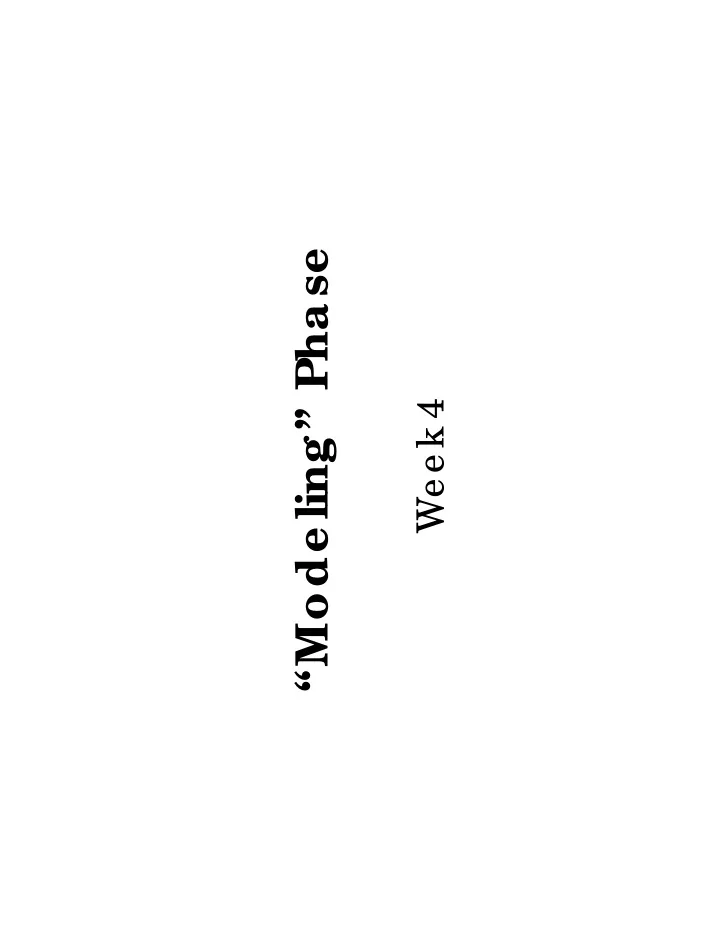

“Mode ling ” Pha se Mode ling Pha se We e k 4
Announcement Announcement • Midterm I – Monday March, 7 th • Scope S – Ch. 1, 2, 3, 4 and Ch. 6 of the text book – Ch. 1, 2 and 3 of the lab book Ch 1 2 and 3 of the lab book
Agenda (Lecture) Agenda (Lecture) • “Modeling phase” or equivalent phase “M d li h ” i l t h
Agenda (Lab) Agenda (Lab) • Weekly progress report • Lab/homework assignments
Team Homework Assignment #5 Team Homework Assignment #5 • Study the analysis modeling for WebApps (Ch 7 or related materials) and prepare for ) p p presentation slides. • Due date is 7:00 pm, February 21 th Due date is 7:00 pm, February 21
Team Lab Assignment #4 Team Lab Assignment #4 • Submit the first version of analysis modeling • Submit the first version of analysis modeling diagrams for your group project – Make slides for presentation Make slides for presentation • Due date – The beginning of the 2/21 lab session
WebE Process Activities & Actions WebE Process Activities & Actions
Chapter 6: The Modeling Activity Chapter 6: The Modeling Activity • Analysis modeling helps you to understand the nature of the problem being addressed and the nature of the problem being addressed and the “shape” of the WebApp that will allow you to address that problem • Design modeling is about understanding the internal structure of the WebApp being developed and how pp g p this creates the shape of the WebApp that was identified by the analysis model.
Modeling Languages Modeling Languages • A modeling language (ML) incorporates a set of notations terms and/or symbols as well as the rules notations, terms, and/or symbols, as well as the rules for establishing associations between them • A modeling language often has a formally structured A d li l f h f ll d representation as well as a set of graphical elements • Some MLs are general purpose (e.g., UML) and others are more specific (e.g., WebML)
Modeling Languages Modeling Languages What Capabilities Should Exist to Model Functionality? • Ability to model integration and connectivity. – Ability to support pattern modeling. – Ability to represent concepts in a technology ‐ neutral fashion. – Ability to model sophisticated system functionality. – What Capabilities Should Exist to Model Information Content? • Ability to model presentation ‐ level concepts. – Ability to model navigational structure and behavior. – Ability to model user interactions with the information. – Ability to model user roles and user groups. Ability to model user roles and user groups. – Ability to model content. – What Generic Capabilities Should Exist in a Modeling Language? • Ability to model business domain concepts. – Ability to link business models with the technical architecture. Ability to link business models with the technical architecture – Ability to link information with functionality. – Ability to maintain system integrity. – Ability to support understanding and communication. – Ability to support Web system life cycle management. –
We b Applic atio n Mo de ling We b Applic atio n Mo de ling Co nte nt = info rmatio n + applic atio n lo gic (hype rte xt o rie nte d vs pre se ntatio n o rie nte d) (hype rte xt-o rie nte d vs. pre se ntatio n-o rie nte d) Co nside r the c o nte xt: use rs’ pre fe re nc e , de vic e c harac te ristic s, de vic e c harac te ristic s, bandwidth re stric tio ns, e tc . Agile vs. RU P Static info rmatio n drive n vs. high inte rac tio n drive n
We b Me tho do lo gie s We b Me tho do lo gie s HDM RMM HDM- L ite OOHD M WSDM WAE We bML W2000 UWE OOWS WAE 2 He ra OO- H 12 (K appe l, Pro ll, e t al 2003/ 2006, pg. 59)
Web b Mo o de l ls an nd M e tho o ds (K appe e l, Pro ll, e t t al 2003/ / 2006, pg. . 60) 13
We b Mo de lling L We b Mo de lling L anguage s: the gap be twe e n re quire me nts and anguage s: the gap be twe e n re quire me nts and c urre nt e xe mplars, Gu e t. al. 2002
References References • www.csun.edu/~twang/595WEB/Slides/WebA ppsModeling pdf ppsModeling.pdf • www.csun.edu/~twang/595WEB/Slides/UWE. / g/ / / pdf • www.csun.edu/~twang/595WEB/Slides/Web ML.pdf
Recommend
More recommend